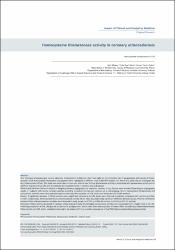| dc.contributor.author | Altinay, Aylin | |
| dc.contributor.author | Kisa, Ucler | |
| dc.contributor.author | Tulmac, Murat | |
| dc.contributor.author | Ozkan, Yesim | |
| dc.date.accessioned | 2021-01-14T18:10:21Z | |
| dc.date.available | 2021-01-14T18:10:21Z | |
| dc.date.issued | 2020 | |
| dc.identifier.citation | Aylin Altınay, Ucler Kısa, Murat Tulmac, Yesim Ozkan. Homocysteine thiolactonase activity in coronary atherosclerosis. Ann Clin Anal Med 2020;11(6):634-638. | en_US |
| dc.identifier.issn | 2667-663X | |
| dc.identifier.uri | https://doi.org/10.4328/ACAM.20168 | |
| dc.identifier.uri | https://hdl.handle.net/20.500.12587/12536 | |
| dc.description | WOS:000582489100021 | en_US |
| dc.description.abstract | Aim: Discovery of paraoxonase natural substrate, homocysteine thiolactone, shed more light on the protective role of paraoxonase and toxicity of homocysteine. Since homocysteine thiolactone and paraoxon were hydrolyzed at different sites in the PON protein, the aim of this study was to investigate the Hcy-thiolactonase (HTase). This study was undertaken to ascertain whether low the Hcy-thiolactonase acitivity is associated with paraoxonase activity and to clarify its relation with ox-LDL and total plasma homocysteine levels in coronary artery diseasase. Material and Methods: Forty-six subjects undergoing coronary angiography for suspected coronary artery disease were included. Depending on angiography results, 14 subjects with normal coronary arteries according to Gensini scoring were selected as a control group. Serum homocysteine thiolactonase and paraoxonase activities were measured spectrophotometrically. Homocysteine, ox-LDL levels were measured with ELISA methods. Results: A significant decrease in HTase activity and a significant increase in ox-LDL levels were observed in patients compared with controls (p=0.040, p=0.037, respectively). Homocysteine levels and paraoxonase activity did not show any statistically significant difference between groups. Positive correlations between HTase and paraoxonase activities were observed in study groups (rs=0.742, p=0.004 for control, rs=0.494, p=0.01 for patient). Discussion: HTase activity decreased in coronary artery disease in spite of unchanged paraoxonase activity and is associated with a higher level of ox-LDL. N-homocysteinylation of HDL changes the properties of apolipoprotein, which could affect the enzymatic activities. When considering a relationship between HTase activity and HDL levels, correlation observed in our study confirms a possible consequence of low PONs homocysteine thiolactonase activity. | en_US |
| dc.description.sponsorship | Gazi University Research FundGazi University | en_US |
| dc.description.sponsorship | This study was supported by Gazi University Research Fund (Protocol no: 02/2006-13). The funders had no role in study design, data collection, and analysis, decision to publish, or preparation of the manuscript. | en_US |
| dc.language.iso | eng | en_US |
| dc.publisher | BAYRAKOL MEDICAL PUBLISHER | en_US |
| dc.relation.isversionof | 10.4328/ACAM.20168 | en_US |
| dc.rights | info:eu-repo/semantics/openAccess | en_US |
| dc.subject | Homocysteine | en_US |
| dc.subject | Homocysteine Thiolactone | en_US |
| dc.subject | Paraoxonase | en_US |
| dc.subject | Oxide LDL | en_US |
| dc.subject | Gensini score | en_US |
| dc.title | Homocysteine thiolactonase activity in coronary atherosclerosis | en_US |
| dc.type | article | en_US |
| dc.contributor.department | KKÜ | en_US |
| dc.identifier.volume | 11 | en_US |
| dc.identifier.issue | 6 | en_US |
| dc.identifier.startpage | 634 | en_US |
| dc.identifier.endpage | 638 | en_US |
| dc.relation.journal | ANNALS OF CLINICAL AND ANALYTICAL MEDICINE | en_US |
| dc.relation.publicationcategory | Makale - Uluslararası Hakemli Dergi - Kurum Öğretim Elemanı | en_US |
















